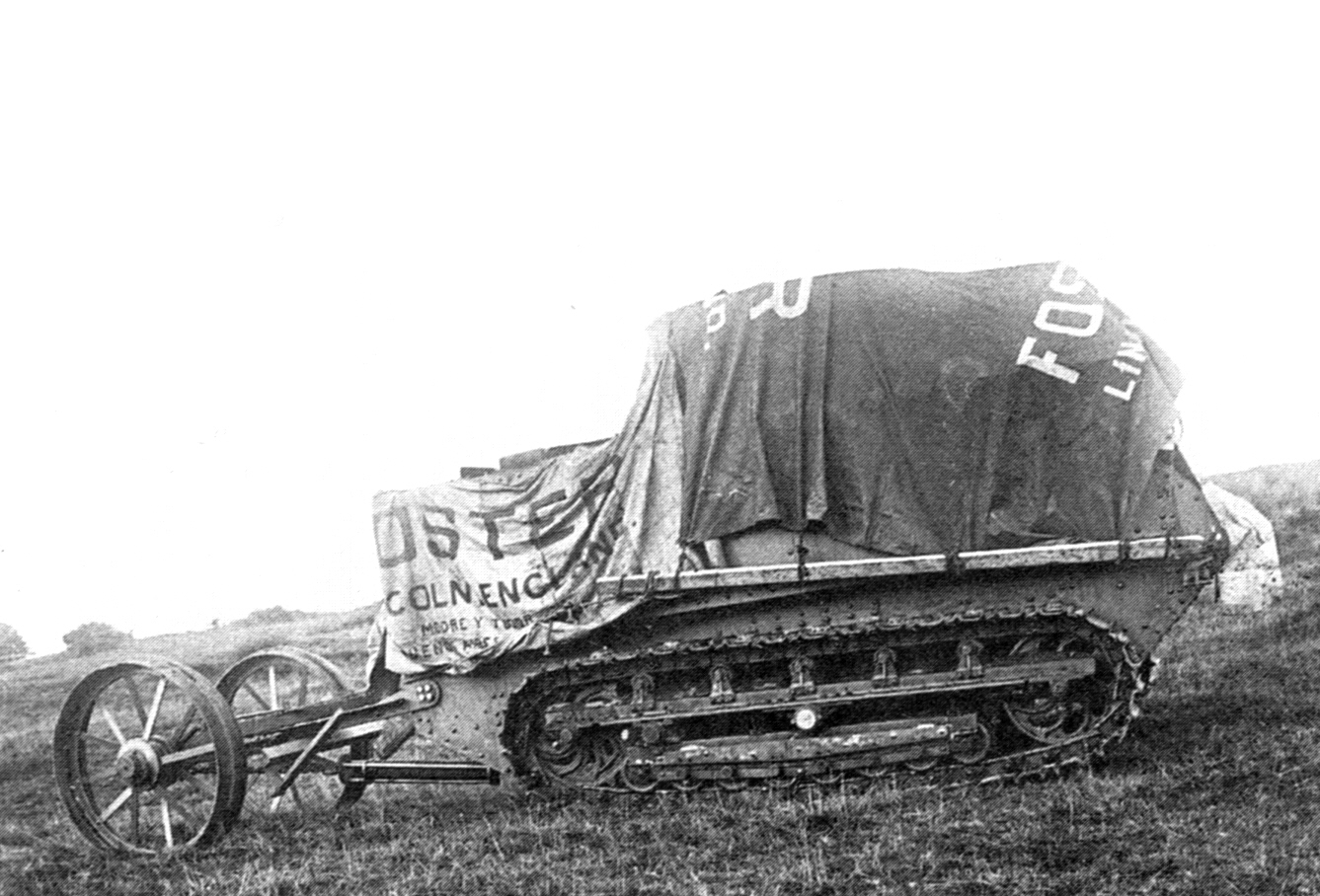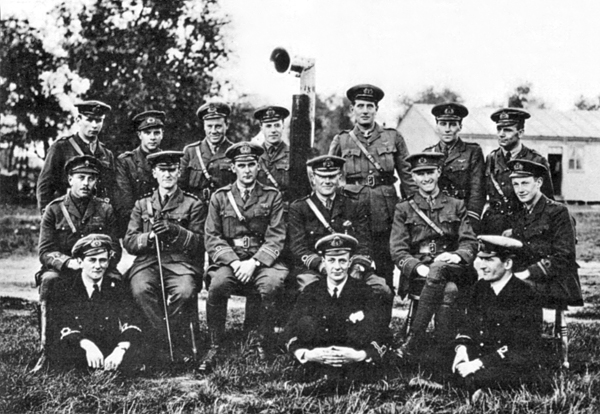|
Walter Gordon Wilson
Major Walter Gordon Wilson (21 April 1874 – 1 July 1957) was an Irish mechanical engineer, inventor and member of the British Royal Naval Air Service. He was credited by the 1919 Royal Commission on Awards to Inventors as the co-inventor of the tank, along with Sir William Tritton. Education Walter was born in Blackrock, County Dublin, on 21 April 1874. In 1888 he enlisted as a midshipman on HMS ''Britannia'', but resigned in 1892. In 1894 he entered King's College, Cambridge, where he studied the mechanical sciences tripos, graduating with a first class degree, B.A., in 1897. Wilson acted as 'mechanic' for the Hon C. S. Rolls on several occasions while they were undergraduates in Cambridge. Aero engine 1898 Interested in powered flight, he collaborated with Percy Sinclair Pilcher and the Hon Adrian Verney-Cave later Lord Braye to attempt to make an aero-engine from 1898. The engine was a flat-twin air cooled and weighed only 40 lb, but shortly before a demonstration ... [...More Info...] [...Related Items...] OR: [Wikipedia] [Google] [Baidu] |
Major (United Kingdom)
Major (Maj) is a military rank which is used by both the British Army and Royal Marines. The rank is superior to captain and subordinate to lieutenant colonel. The insignia for a major is a crown. The equivalent rank in the Royal Navy is lieutenant commander, and squadron leader in the Royal Air Force. History By the time of the Napoleonic wars, an infantry battalion usually had two majors, designated the "senior major" and the "junior major". The senior major effectively acted as second-in-command and the majors often commanded detachments of two or more companies split from the main body. The second-in-command of a battalion or regiment is still a major. File:British-Army-Maj(1856-1867)-Collar Insignia.svg, 1856 to 1867 major's collar rank insignia File:British-Army-Maj(1867-1880)-Collar Insignia.svg, 1867 to 1880 major's collar rank insignia File:British&Empire-Army-Maj(1881-1902).svg, 1881 to 1902 major's shoulder rank insignia During World War I, majors wore the foll ... [...More Info...] [...Related Items...] OR: [Wikipedia] [Google] [Baidu] |
Mark V Tank
The British Mark V tank was an upgraded version of the Mark IV tank. The tank was improved in several aspects over the Mark IV, chiefly the new steering system, transmission and 150 bhp engine, but it fell short in other areas, particularly its insufficient ventilation leading to carbon monoxide poisoning for the crew. Various versions were fitted with a variety of armament including 6-pounder guns and machine guns. It was first deployed in July 1918 on the Western Front at the Battle of Hamel; then at the Battle of Amiens, and on the Hindenburg Line during the closing months of World War I. During the Allied intervention in the Russian Civil War on the White Russian side, four Mark Vs were delivered to Archangelsk, four to Tallinn, Estonia, and around 70 were delivered to Novorossiysk in southern Russia. The survivors were captured and used by the Red Army. There were two main further variants, the lengthened Mark V* and a few Mark V**s with a more powerful engine and ... [...More Info...] [...Related Items...] OR: [Wikipedia] [Google] [Baidu] |
Mark I Tank
British heavy tanks were a series of related armoured fighting vehicles developed by the United Kingdom of Great Britain and Ireland, UK during the First World War. The Mark I was the world's first tank, a tracked, armed, and armoured vehicle, to enter combat. The name "tank" was initially a code name to maintain secrecy and disguise its true purpose by making it appear to be a water transport vehicle for bringing water to the troops at the front line. The tank was developed in 1915 to break the stalemate of trench warfare. It could survive the machine gun and small-arms fire in "no man's land", travel over difficult terrain, crush barbed wire, and cross trenches to assault fortified enemy positions with powerful armament. Tanks also carried supplies and troops. British heavy tanks are distinguished by an unusual rhomboidal shape with a high climbing face of the track, designed to cross the wide and deep Trench warfare, trenches prevalent on the battlefields of the Western Front ... [...More Info...] [...Related Items...] OR: [Wikipedia] [Google] [Baidu] |
Little Willie
Little Willie was a prototype in the development of the British Mark I tank. Constructed in the autumn of 1915 at the behest of the Landship Committee, it was the first completed tank prototype in history. ''Little Willie'' is the oldest surviving individual tank, and is preserved as one of the most famous pieces in the collection of The Tank Museum, Bovington, England. Number 1 Lincoln Machine Work on Little Willie's predecessor was begun in July 1915 by the Landship Committee to meet The United Kingdom's requirement in World War I for an armoured combat vehicle able to cross an trench. After several other projects where single and triple tracks had failed, on 22 July William Ashbee Tritton, director of the agricultural machinery company William Foster & Company of Lincoln, was given the contract to develop a "Tritton Machine" with two tracks. It had to make use of the track assemblies – lengthened tracks and suspension elements (seven road wheels instead of four) – pu ... [...More Info...] [...Related Items...] OR: [Wikipedia] [Google] [Baidu] |
Landships Committee
The Landship Committee was a small British committee formed during the First World War to develop armoured fighting vehicles for use on the Western Front. The eventual outcome was the creation of what is now called the tank. Established in February 1915 by First Lord of the Admiralty Winston Churchill, the Committee was composed mainly of naval officers, politicians and engineers. It was chaired by Eustace Tennyson d’Eyncourt, Director of Naval Construction at the Admiralty. For secrecy, by December 1915 the name was changed to "the D.N.C.'s Committee" to disguise its purpose. Formation The committee was formed at Churchill's instruction in February 1915. It started with only three members: d'Eyncourt, as chairman; Flight Commander Thomas Hetherington of the Royal Naval Air Service Armoured Car Squadron; and Colonel Wilfred Dumble of the Naval Brigade. Hetherington had proposed a large wheeled landship, estimated to weigh some 300 tons. A former Royal Engineer, Dumble had m ... [...More Info...] [...Related Items...] OR: [Wikipedia] [Google] [Baidu] |
British Admiralty
The Admiralty was a department of the Government of the United Kingdom responsible for the command of the Royal Navy until 1964, historically under its titular head, the Lord High Admiral – one of the Great Officers of State. For much of its history, from the early 18th century until its abolition, the role of the Lord High Admiral was almost invariably put "in commission" and exercised by the Lords Commissioner of the Admiralty, who sat on the governing Board of Admiralty, rather than by a single person. The Admiralty was replaced by the Admiralty Board in 1964, as part of the reforms that created the Ministry of Defence and its Navy Department (later Navy Command). Before the Acts of Union 1707, the Office of the Admiralty and Marine Affairs administered the Royal Navy of the Kingdom of England, which merged with the Royal Scots Navy and the absorbed the responsibilities of the Lord High Admiral of the Kingdom of Scotland with the unification of the Kingdom of G ... [...More Info...] [...Related Items...] OR: [Wikipedia] [Google] [Baidu] |
Royal Naval Armoured Car Division
The Royal Naval Air Service (RNAS) was the air arm of the Royal Navy, under the direction of the Admiralty's Air Department, and existed formally from 1 July 1914 to 1 April 1918, when it was merged with the British Army's Royal Flying Corps to form the Royal Air Force (RAF), the world's first independent air force. It was replaced by the Fleet Air Arm, initially consisting of those RAF units that normally operated from ships, but emerging as a separate unit similar to the original RNAS by the time of World War 2. Background In 1908, the British Government recognised the military potential of aircraft. The Prime Minister, H. H. Asquith, approved the formation of an "Advisory Committee for Aeronautics" and an "Aerial Sub-Committee of the Committee of Imperial Defence". Both committees were composed of politicians, army officers and Royal Navy officers. On 21 July 1908 Captain Reginald Bacon, who was a member of the Aerial Navigation sub-committee, submitted to the First Se ... [...More Info...] [...Related Items...] OR: [Wikipedia] [Google] [Baidu] |
J & E Hall
J & E Hall is an English manufacturer of refrigeration equipment (today part of the Daikin group). It was originally established as an iron works in Dartford, Kent in 1785, with products including papermaking machines, steam engines and gun carriages, before it started producing refrigeration machinery in the 1880s. During the early 20th century, the company diversified to produce commercial vehicles (branded as Hallford, 1906–1926), lifts and escalators, before refocusing on its core refrigeration and air conditioning products in the late 1960s. The company retains a head office and some R&D facilities in Dartford. History The company was originally established in 1785 in Lowfield Street, Dartford by smith and millwright John Hall (1764–1836). Originally from Alton, Hampshire, the second son of a millwright who had previously worked in Dartford, Hall moved to Dartford in 1784, and was employed to repair a mill on the River Darent in Hawley, after which he set up his own busine ... [...More Info...] [...Related Items...] OR: [Wikipedia] [Google] [Baidu] |
Oxford Dictionary Of National Biography
The ''Dictionary of National Biography'' (''DNB'') is a standard work of reference on notable figures from British history, published since 1885. The updated ''Oxford Dictionary of National Biography'' (''ODNB'') was published on 23 September 2004 in 60 volumes and online, with 50,113 biographical articles covering 54,922 lives. First series Hoping to emulate national biographical collections published elsewhere in Europe, such as the '' Allgemeine Deutsche Biographie'' (1875), in 1882 the publisher George Smith (1824–1901), of Smith, Elder & Co., planned a universal dictionary that would include biographical entries on individuals from world history. He approached Leslie Stephen, then editor of the '' Cornhill Magazine'', owned by Smith, to become the editor. Stephen persuaded Smith that the work should focus only on subjects from the United Kingdom and its present and former colonies. An early working title was the ''Biographia Britannica'', the name of an earlier eig ... [...More Info...] [...Related Items...] OR: [Wikipedia] [Google] [Baidu] |
Armstrong Whitworth
Sir W G Armstrong Whitworth & Co Ltd was a major British manufacturing company of the early years of the 20th century. With headquarters in Elswick, Newcastle upon Tyne, Armstrong Whitworth built armaments, ships, locomotives, automobiles and aircraft. The company was founded by William Armstrong in 1847, becoming Armstrong Mitchell and then Armstrong Whitworth through mergers. In 1927, it merged with Vickers Limited to form Vickers-Armstrongs, with its automobile and aircraft interests purchased by J D Siddeley. History In 1847, the engineer William George Armstrong founded the Elswick works at Newcastle, to produce hydraulic machinery, cranes and bridges, soon to be followed by artillery, notably the Armstrong breech-loading gun, with which the British Army was re-equipped after the Crimean War. In 1882, it merged with the shipbuilding firm of Charles Mitchell to form Armstrong Mitchell & Company and at the time its works extended for over a mile (about 2 km) a ... [...More Info...] [...Related Items...] OR: [Wikipedia] [Google] [Baidu] |
Gears
A gear is a rotating circular machine part having cut teeth or, in the case of a cogwheel or gearwheel, inserted teeth (called ''cogs''), which mesh with another (compatible) toothed part to transmit (convert) torque and speed. The basic principle behind the operation of gears is analogous to the basic principle of levers. A gear may also be known informally as a cog. Geared devices can change the speed, torque, and direction of a power source. Gears of different sizes produce a change in torque, creating a mechanical advantage, through their ''gear ratio'', and thus may be considered a simple machine. The rotational speeds, and the torques, of two meshing gears differ in proportion to their diameters. The teeth on the two meshing gears all have the same shape. Two or more meshing gears, working in a sequence, are called a gear train or a ''transmission''. The gears in a transmission are analogous to the wheels in a crossed, belt pulley system. An advantage of gears i ... [...More Info...] [...Related Items...] OR: [Wikipedia] [Google] [Baidu] |





.jpg)
